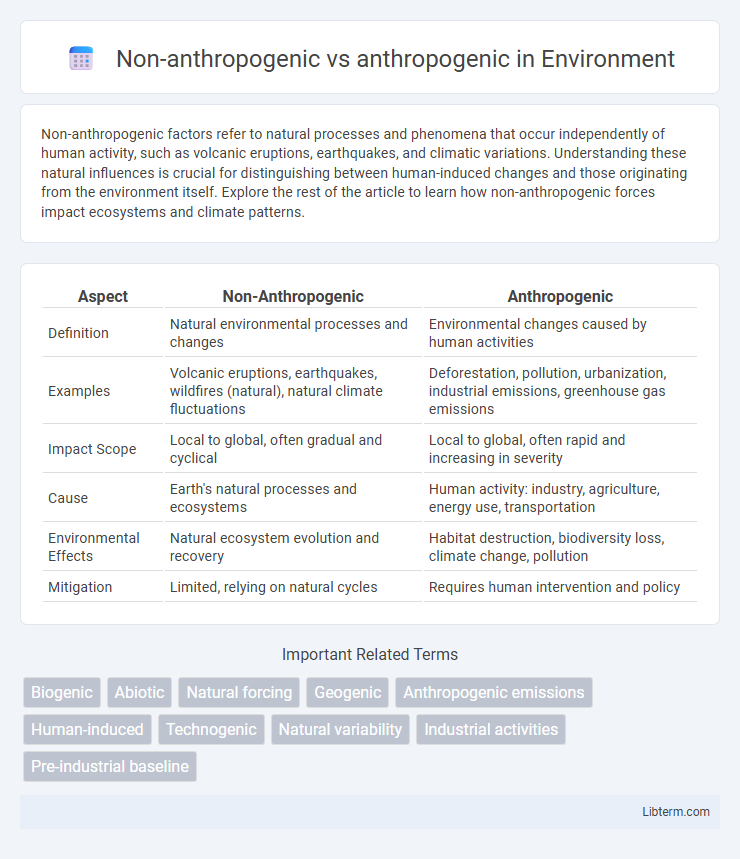Non-anthropogenic factors refer to natural processes and phenomena that occur independently of human activity, such as volcanic eruptions, earthquakes, and climatic variations. Understanding these natural influences is crucial for distinguishing between human-induced changes and those originating from the environment itself. Explore the rest of the article to learn how non-anthropogenic forces impact ecosystems and climate patterns.
Table of Comparison
| Aspect | Non-Anthropogenic | Anthropogenic |
|---|---|---|
| Definition | Natural environmental processes and changes | Environmental changes caused by human activities |
| Examples | Volcanic eruptions, earthquakes, wildfires (natural), natural climate fluctuations | Deforestation, pollution, urbanization, industrial emissions, greenhouse gas emissions |
| Impact Scope | Local to global, often gradual and cyclical | Local to global, often rapid and increasing in severity |
| Cause | Earth's natural processes and ecosystems | Human activity: industry, agriculture, energy use, transportation |
| Environmental Effects | Natural ecosystem evolution and recovery | Habitat destruction, biodiversity loss, climate change, pollution |
| Mitigation | Limited, relying on natural cycles | Requires human intervention and policy |
Defining Non-Anthropogenic and Anthropogenic Factors
Non-anthropogenic factors refer to natural processes and phenomena that occur without human influence, such as volcanic eruptions, solar radiation variations, and natural climate cycles. Anthropogenic factors encompass human-induced activities, including greenhouse gas emissions from fossil fuel combustion, deforestation, and industrial pollution. Distinguishing between these factors is crucial for accurately assessing environmental changes and developing effective climate mitigation strategies.
Historical Context of Human vs. Natural Influences
Non-anthropogenic factors such as volcanic eruptions, solar variability, and natural climate cycles have historically shaped Earth's environment long before significant human influence emerged. Anthropogenic impacts, primarily since the Industrial Revolution, include greenhouse gas emissions, deforestation, and urbanization, which have accelerated climate change and altered ecosystems at unprecedented rates. Studies of ice cores and sediment records reveal natural variability over millennia, but recent data highlight the dominant role of human activities in recent global warming trends.
Key Sources of Non-Anthropogenic Changes
Key sources of non-anthropogenic changes include natural phenomena such as volcanic eruptions, solar radiation variations, and oceanic cycles like El Nino and La Nina. Volcanic eruptions release large quantities of aerosols and greenhouse gases that influence atmospheric composition and climate patterns. Solar irradiance fluctuations affect global temperatures through changes in the energy received by the Earth's surface.
Major Anthropogenic Activities Impacting the Environment
Major anthropogenic activities impacting the environment include industrial manufacturing, deforestation, fossil fuel combustion, and intensive agriculture, which significantly contribute to greenhouse gas emissions, habitat loss, and pollution. These human-driven processes accelerate climate change, biodiversity decline, and soil degradation, contrasting with non-anthropogenic natural phenomena such as volcanic eruptions and wildfires that also affect ecosystems but occur without human influence. Understanding the scale and scope of anthropogenic effects is crucial for implementing effective environmental policies and sustainability practices.
Climate Impacts: Natural vs. Human-Driven
Non-anthropogenic climate impacts arise from natural phenomena such as volcanic eruptions, solar variations, and oceanic cycles, contributing to temperature fluctuations and weather pattern shifts over geological timescales. Anthropogenic climate impacts result primarily from greenhouse gas emissions, deforestation, and industrial activities, accelerating global warming and causing unprecedented changes in climate systems. Scientific consensus attributes recent rapid climate change predominantly to human-driven factors, intensifying extreme weather events, sea-level rise, and ecosystem disruptions.
Biodiversity Effects: Comparing Both Forces
Non-anthropogenic factors such as natural climatic variations and volcanic eruptions historically drive biodiversity changes through habitat alteration and species migration. Anthropogenic influences including deforestation, pollution, and urbanization accelerate species extinction rates and disrupt ecosystems more rapidly than natural processes. Comparing both forces reveals that human activities intensify biodiversity loss by fragmenting habitats and introducing invasive species, leading to reduced genetic diversity and ecosystem resilience.
Case Studies: Anthropic and Natural Environmental Events
Case studies contrasting non-anthropogenic and anthropogenic environmental events highlight the differing impacts on ecosystems and climate. Natural phenomena such as volcanic eruptions and wildfires occur independently of human activity and often lead to short-term environmental changes, while anthropogenic events like industrial pollution and deforestation cause persistent, large-scale ecological disruptions. Detailed analyses of incidents like the 1980 Mount St. Helens eruption versus the extensive Amazon deforestation reveal significant contrasts in environmental recovery and long-term sustainability.
Detection and Measurement of Influence Origins
Detection and measurement of influence origins distinguish non-anthropogenic factors, such as volcanic eruptions and solar variability, from anthropogenic sources like fossil fuel combustion and deforestation. Advanced tools including remote sensing, isotopic analysis, and climate modeling quantify contributions from natural versus human-induced effects on climate change. Accurate attribution enables targeted mitigation strategies by isolating the specific impact of anthropogenic emissions on global temperature trends.
Mitigation and Adaptation Strategies
Non-anthropogenic factors refer to natural processes like volcanic eruptions and solar variations, which largely require adaptive strategies such as ecosystem resilience enhancement and disaster preparedness. Anthropogenic factors stem from human activities, notably fossil fuel combustion and deforestation, necessitating mitigation methods like carbon emission reduction, renewable energy adoption, and reforestation projects. Effective climate policy integrates both adaptive responses to natural variability and mitigation efforts targeting human-induced emissions to combat global warming comprehensively.
Future Outlook: Balancing Human and Natural Interactions
Future outlooks emphasize harmonizing anthropogenic activities with non-anthropogenic processes to foster sustainable ecosystems. Advanced monitoring technologies and environmental policies aim to mitigate human impact while preserving natural dynamics essential for climate resilience. Integrating green infrastructure and sustainable development practices drives progress towards balancing human needs with ecological integrity.
Non-anthropogenic Infographic

 libterm.com
libterm.com